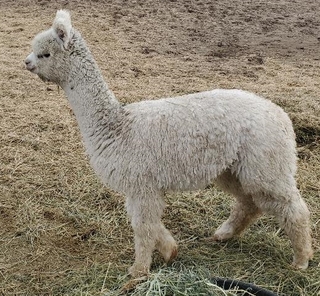Monday, January 17, 2022
Dummy Foal Syndrome

Sawdust's Holly
Sawdust's Holly as of 1/15/22
I was asked today about one of our crias (babies) that had this condition. So here is what I have learned:
Neonatal Maladjustment Syndrome in Foals (commonly referred to as Dummy Foal Syndrome) is normally attributed to horses. However, other animals can also have a form of this condition.
Our Sawdust's Holly was born May 29, 2021, weighing 14.6 lbs. She appeared to be fine when born but within a short period of time, she found a corner of the barn and just stood there, facing the wall. We tried to get her out to her Mom, light, etc. but with no luck. She couldn't or wouldn't try to find her Mom, she would not try to nurse which she should have been doing within a short time. We were really worried about her. Since it was a holiday, there were no vets available in our town. We were advised to call the vet hospital about an hour and a half from us. We called them and they recommended we take her to UC Davis Vet School in Davis CA. That would be about a 5 hour drive and we were afraid Miss Holly would not survive that trip.
We called friends in the alpaca industry and were referred to an article from UC Davis regarding this Dummy Foal Syndrome, which everyone said Holly appeared to have. So we printed the article and sure enough Miss Holly had the symptoms. Healthy at birth, but then become detached, disoriented, unresponsive, have trouble nursing. And she lost 3 pounds over the next few days.
So what causes this problem? Apparently the disorder is associated with rapid birth low oxygen levels affecting the brain. There is no long term brain injury and an 80% recovery rate with intensive care. Dr. John Madigan of UC Davis Veterinary thinks that the journey thru the birth canal activates a biochemical switch that enables newborns to transition form a calm, sedative state in the womb to alert consciousness. When this transition does not occur the newborn remains in the quiet state of the womb. Dr Madigan developed a Squeeze technique the acts to stimulate the Switch to alert state. This technique uses a rope with a bowline knot placed in specific places on the body and puts a little pressure on the chest. Apply steady pressure on the ropes until the animal falls asleep. Maintain that pressure for about 20 minutes. Release pressure and allow the animal to get up as they wish.
What is required to keep these crias or foals alive? We bottle fed every few hours with Vitamin D milk with Critical Care Manna in it. We massaged the roof of her mouth to get the sucking reflex going. We massaged the base of her neck to stimulate the nerves. We did this from Friday night until Wednesday when the vet was finally able to come. The Vet's first action was an IV with antibiotics and fluids, then a plasma transfer. The next 2 days were spent doing the Madigan Squeeze Technique. The IV remained for 4 days.
Miss Holly is our miracle baby and we are so happy. She is active, healthy, and doing great.